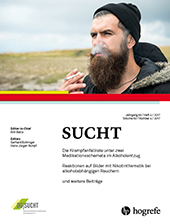Abstract
Zusammenfassung.Einleitung: In der verhaltenstherapeutisch orientierten Raucherbehandlung spielt die Identifizierung von Auslösesituationen eines aufkommenden Rauchdrucks eine große Rolle. Im Rahmen der bisherigen Forschung konnte gezeigt werden, dass bildliche Darstellungen mit Nikotinthematik aus der Anfangsphase des Rauchrituals einen hohen Anreizwert besitzen, Bilder aus der Endphase eines Rauchvorgangs jedoch kaum Nikotincraving auslösen. Unsere Arbeit beschäftigt sich mit der Frage, ob bei Rauchern mit einer zusätzlichen Alkoholabhängigkeit auch die an sich wenig einladenden Darstellungen aus der Endphase anders als bei den bislang untersuchten Rauchern ohne Substanzabhängigkeiten ein hohes Rauchverlangen auslösen. Methode: In zwei Studien wurden jeweils 12 männliche und 12 weibliche Probanden mit einer kombinierten Alkohol- und Tabakabhängigkeit untersucht. Den Studienteilnehmern wurden auf einem Farbmonitor Bilder mit Nikotinthematik aus den verschiedenen Phasen des Rauchrituals präsentiert. Jedes Bild sollte in Hinblick auf das ausgelöste Rauchverlangen (Craving) sowie zu den beiden emotionalen Dimensionen Valenz und Arousal bewertet werden. Bildmaterial und Bildbeurteilung wurden bereits in einer Reihe von Studien eingesetzt. Ergebnisse: Auch bei unseren alkohol- und tabakabhängigen Probanden lösten Bilder aus der Anfangsphase des Rauchrituals ein höheres Rauchverlangen aus als Bilder aus der Endphase. Es zeigte sich aber auch ein geschlechtsspezifischer Interaktionseffekt: Frauen reagierten auf das wenig einladende Bildmaterial der Endphase mit einem höheren Rauchverlangen als Männer. Dabei schien die bei den Bildpräsentationen generierte Erregung (Arousal) die modulierende Größe bei der Entstehung dieses Befundes zu sein. Diskussion: Hier soll aufgezeigt werden, dass sich in Hinblick auf unsere Ergebnisse bei der Behandlung der Tabakabhängigkeit die Aufgabe stellt, in gemischtgeschlechtlichen Gruppenformaten frauenspezifische Auslösesituationen etwa im Bereich von Stress und Erregung explizit und ausführlich anzusprechen.
Abstract.Introduction: In behavioural smoking cessation interventions the identification of triggers for craving is a major aim. Previous research showed pictorial presentation with nicotine-related content from the initial phase of the smoking ritual to be of highly incentive character, whereas pictures from the terminal phase hardly trigger any craving at all. The underlying question of this study is as to which extent pictorial presentations from the terminal phase of smoking, other than in usual smokers, cause nicotine craving in a population of smokers with an additional addiction to alcohol. Methods: We conducted two studies, each including 12 males and 12 females with a combined alcohol- and tobacco dependence. The participants were presented pictures with smoking-related content from the different phases of the smoking ritual. Participants provided subjective reports of smoking-related craving and affective reactions such as valence and arousal. Picture material and rating mode have frequently been applied in previous research. Results: As in previous studies with smokers without a diagnosis of substance abuse, in our population of alcohol-dependent smokers pictures from the initial phase of smoking resulted in a higher degree of nicotine craving than pictures from the terminal phase. But, in addition, we observed a gender-specific interaction effect: For the more unpleasant visual content from the terminal phase, females reported a significantly higher nicotine craving than males. Our analyses suggest the arousal following the picture viewing to be responsible for this finding. Discussion: Possible implications for gender-specific smoking treatment are being discussed. Triggers for nicotine craving, which are of particular importance in women, should receive special attention in these programs.
Literatur
(1991). Internationale Klassifikation psychischer Störungen: ICD-10, Kapitel V (F), klinisch-diagnostische Leitlinien, Weltgesundheitsorganisation. Bern: Huber.
(2005). Craving and other characteristics of the comorbidity of alcohol and nicotine dependence. European Psychiatry, 20(5–6), 442–450. doi: 10.1016/j.eurpsy. 2005.06.003
(1997). International affective picture system (IAPS): Technical manual and affective ratings. NIMH Center for the Study of Emotion and Attention, 39–58.
(1997). Nicotine dependence and withdrawal in alcoholic and nonalcoholic ever-smokers. Journal of Substance Abuse Treatment, 14(6), 521–527. doi: 10.1016/S0740-5472(97)00049-4
(1999). Modulation of craving by cues having differential overlap with pharmacological effect: evidence for cue approach in smokers and social drinkers. Psychopharmacology, 147(3), 306–313. doi: 10.1007/s002130051172
(2008). Smoking stimuli from the terminal phase of cigarette consumption may not be cues for smoking in healthy smokers. Psychopharmacology, 201(1), 81–95. doi: 10.1007/s00213-008-1249-x
(2011). Men’s smoking cessation interventions: a brief review. Journal of Men’s Health, 8(2), 100–108.
(2012). Gender Differences in Craving and Cue Reactivity to Smoking and Negative Affect/Stress Cues. The American Journal on Addictions, 21(3), 210–220. doi: 10.1111/j.1521-0391.2012.00232.x
(2010). Neural Responses to BEGIN- and END-Stimuli of the Smoking Ritual in Nonsmokers, Nondeprived Smokers, and Deprived Smokers. Neuropsychopharmacology, 35(5), 1209–1225. doi: 10.1038/npp.2009.227
(2012). Smoking Cessation Programs Targeted to Women: A Systematic Review. Women & Health, 52(1), 32–54. doi: 10.1080/ 03630242.2011.637611
(2011). Conditioned cues for smoking elicit preparatory responses in healthy smokers. Psychopharmacology, 213(4), 781–789.
(2015). Gender Differences in Responses to Cues Presented in the Natural Environment of Cigarette Smokers. Nicotine & Tobacco Research, 17(4), 438–442. doi: 10.1093/ntr/ntu248
(1996). Integrierte Raucherentwöhnung in ei- ner Fachklinik für Alkohol-und Medikamentenabhängige. Praxis der klinischen Verhaltensmedizin und Rehabilitation, 34, 90–96.



